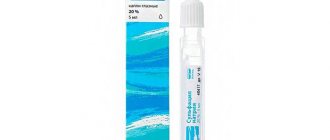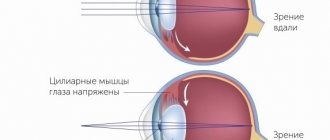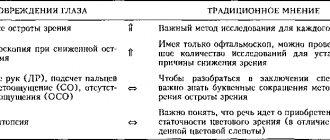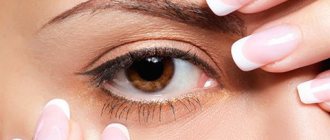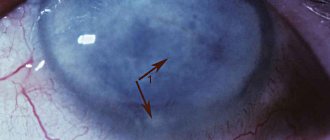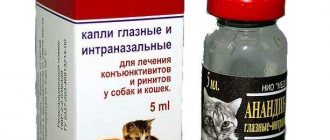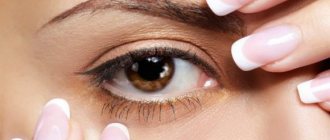What it is
The Schirmer test is an ophthalmological procedure that helps determine how much tear fluid the gland secretes to moisten the eye, and whether it is sufficient to do this. The test easily detects dry eye syndrome. Usually the test is performed on both eyes at the same time. Among all studies, this is the simplest and fastest test that gives results instantly and quite accurately.
The Schirmer test is prescribed and performed by an ophthalmologist in the clinic; if certain abnormalities are detected in the test, the doctor will prescribe additional studies. With its help, the ophthalmologist determines the level of tear fluid secreted and the general condition of the eye itself.
Early detection of abnormalities can help avoid serious eye pathologies in the future.
Schirmer strip test
In what situations do doctors resort to this test?
The Schirmer test detects symptoms of dry eye, as well as a number of other serious conditions. Symptoms of dry eye include the following situations:
-excessive dryness in the eyes;
- constant tearing;
-pain in the eye area;
-feeling of a foreign body in the eye;
- chronic eye irritation;
- sensitivity to light.
The Schirmer test can also be used to diagnose Sjögren's syndrome. It is an autoimmune disorder that causes decreased function of the eye and salivary glands, resulting in dry mouth and dry eyes.
To detect Sjögren's syndrome, the Schirmer test is often used in combination with other medical tests.
How is the Schirmer test performed?
First way
There are two ways to perform this test - with your eyes closed and with your eyes open. With each of them, the doctor places the curved end of the strip under the patient’s lower eyelid. The room in which the test is performed must have lighting that is comfortable for the patient. The strips are inserted at an angle of 45 degrees, closer to the outer third of the eyelid. The Schirmer test is carried out for five minutes, after which the doctor removes the strips and assesses the moisture level of the eye itself based on the degree of their moisture.
- With eyes closed, the patient sits in a comfortable position in a chair.
- With eyes open, reflex blinking is allowed. With this method, the patient is instructed to look forward and slightly upward.
Sometimes the test requires short-term local anesthesia. To do this, an anesthetic is instilled under the lower eyelid a few minutes before the examination. Its effect gradually ceases a few minutes after the end of the test. To do this, the doctor clarifies that the patient is not allergic to this anesthetic, and the eye itself is dried - tears should not mix with the anesthetic itself. Although many eye doctors prefer to test without using anesthesia, it may be necessary to prevent irritation from the paper strips. Then the test is incomplete.
Second way
It is carried out in almost the same way as the first one, but it happens that there is a need to clarify the results. Then testing is carried out using external irritation of the nasal passages with a cotton swab. With this method, the indicators will be slightly higher.
Schirmer test
How is the Schirmer test performed?
Preparation for the Schirmer test is minimally simple. The patient undergoing the test must remove contact lenses or glasses.
The whole process lasts about 5 minutes. Before the test, the doctor asks the patient about intolerance to specific drugs or things.
If your eyes experience discomfort, your doctor may use special drops.
The ophthalmologist then places 2 strips of paper on the lower eyelids and asks the person to close their eyes for 5 minutes. Most patients admit that the test is slightly irritating and unpleasant.
After the test, it is recommended to avoid rubbing or irritating your eyes for 30 minutes. Additionally, patients should not wear contact lenses for approximately 2 hours after the test.
Apart from these two recommendations, there are no other short-term or long-term side effects or contraindications for this procedure.
results
After testing, the doctor looks at the results. They often depend not only on the condition of the eye itself, but also on the age of the patient. So, at a younger age, the stripes will get wet more than those of older people and the elderly. For example, a person under 25 years of age normally moistens 15 mm strips in a five-minute test. For the Schirmer test, the norm is considered to be hydration of 10 mm or more.
The entire Schirmer test is considered positive if it confirms dry eye syndrome. If the patient does not get the strips wet at all within five minutes of the test, he is diagnosed with dry eye syndrome (DES) and treatment is prescribed.
Test results vary by level
- Normal - ≥15 mm of strip wetted,
- Soft - wetted from 14 to 10 mm
- Moderate - from 9 to 5 mm
- Heavy - less than 4 mm wetted.
The doctor and the patient should be alert to the result in which the difference in tear production in both eyes is more than 25%.
How is it carried out in people?
To carry out the test, thin ophthalmic strips of filtered paper of standard size are required (length is three and a half cm, width is five mm) with a clearly defined edge. The ophthalmologist steps back from the latter at a distance of five mm and bends the strip at an angle of forty-five degrees, placing it behind the lower eyelid between the outer and middle parts, carefully so as not to provoke injury to the cornea.
The procedure lasts 5 minutes and is carried out in two ways:
- without the use of anesthetics - a number of experts believe that these drugs do not give a pure result;
- using an anesthetic , which prevents lacrimation during the examination and the mixing of basal fluid with tears. After using the drug, the lower fornix of the conjunctiva must be dried, since excess fluid can distort the test results. A preliminary allergy test is required.
Advice! This study is considered absolutely harmless to health, taking into account the fact that complications are extremely rare and usually involve allergic reactions to the components of the indicator. This point should be discussed with your doctor.
Schirmer test type I
During the test, the specialist recommends closing your eyes for a while or not closing them, and also looking slightly upward. The duration of the study is about five minutes. During this time, the paper absorbs the precorneal tear film and moisture from the tear lake. Before conducting the study, you need to wash off decorative cosmetics and remove contact lenses.
Attention! A huge role is played by indoor lighting, which should not be made too bright or dim.
Schirmer test type II
The methodology is similar to the previous type of study. But in this situation, reflex stimulation is used. It involves irritating the mucous membrane of the nasal passages using cotton swabs. Sometimes during the test the patient is asked to inhale ammonia vapor. This study has a wider range of normative values.
Follow-up diagnostics
In case of poor results during the Schirmer test, an additional slit lamp examination is performed to determine the integrity of the tear film, staining with rose bengal or fluorescein.
Now there are several more modern studies alternative to this test, in which the tear fluid itself is examined. These tests give more accurate results and better diagnose the disease. They are more expensive, take longer to make, and cover more parameters. They are prescribed for a more in-depth analysis of the patient’s condition in case of unsatisfactory or unclear results during the Schirmer test.
Despite all their simplicity and safety, these tests are not recommended for everyone; they have several contraindications.
Decoding the results of the Norn test
The interpretation of the results is as follows. When performing the Norn test, the ophthalmologist must record the time of rupture of the tear film of a person’s eye. After several values, the average time is calculated. For different age categories, normal indications are different, so specialists must proceed from age norms when diagnosing a patient. If a person is from 16 to 35 years old, then a complete rupture of the tear membrane of a person’s eye should occur in no less than 21 seconds. this is a completely normal indicator. It is worth noting that you should not blink at this time. The older the person, the shorter the optimal time value. If a person is in the age category from 60 to 80 years, then in normal condition the tear membrane should rupture in 11 seconds.
If the doctor recorded an average time value of 10 seconds, then you should worry, as this value is considered abnormal. If the rupture time of the tear membrane of a person’s eye is only 10 seconds or less, then a specialist can without a doubt diagnose dry eye syndrome. At the next stage, the specialist must determine the cause of such a disease, as well as think over a method of treating it.
Therapy for dry eye syndrome can be varied, but in the vast majority of cases, the syndrome is prescribed by instilling moisturizing drops that imitate tear fluid. During the treatment period, it is better for the patient to stop using the gadget. If the patient’s work involves the use of gadgets, then experts advise taking a break every hour and doing special exercises to relax the eyes. To prevent dry eye syndrome, you need to drink as much fluid as possible, especially during the heating season.
Indications and contraindications
The test is absolutely painless and safe; it can be performed at any age.
Indications
These samples are taken when an ophthalmologist suspects a patient has dry eye syndrome. It occurs in humans due to various reasons, in particular:
- When there is dehydration;
- for keratoconjunctivitis and infectious eye diseases;
- Sjögren's syndrome, or the so-called “secondary syndrome” is an autoimmune systemic disorder of connective tissue that also affects the lacrimal glands. The syndrome requires additional treatment.
- leukoma or eyesore - congenital and acquired;
- with hypovitaminosis, especially lack of vitamin A;
- in case of complicated course of the period after laser vision correction;
- for preventive purposes in elderly patients, even if they have no particular complaints about lacrimation;
- taking certain medications;
- complication of rheumatoid arthritis, leukemia and lymphoma.
Contraindications
Although the procedure itself is simple, there are certain contraindications for its implementation.
- erosion of the stratum corneum of the eyeball
- corneal ulcer
- perforation and change in the shape of the eyeball
- fistulas in the eyeball, fistula
There may also be temporary contraindications - in case of eye injury. It is also not done for colds, runny nose and otitis media - the results may be unreliable. The test will be carried out when all symptoms disappear.
Sources used:
- Taking care of your eyes. Vision problems from dry eye syndrome to macular degeneration. - M.: Art-Rodnik, 2011.
- Kanski, Jack Clinical Ophthalmology. Systematized approach. Chapter 13. Glaucoma / Jack Kanski. - M.: Logosphere, 2010.
- Clinical atlas of fundus pathology / L.A. Katsnelson, V.S. Lysenko, T.I. Balishanskaya. - M.: GEOTAR-Media, 2013.
- FSBI "National Medical Research Center named after. V. A. Almazova" of the Ministry of Health of Russia
Interpretation of results
Schirmer test values help diagnose and monitor dry eye syndrome (DES). But it has other names: “dry” eye, keratoconjunctivitis (KK).
Results may vary according to different sources. The average values are given in Table No. 1.
In cats, the large difference in indicators is due to the presence of stress. For this reason, the Schirmer test may be questionable in these animals and should be considered based on the clinical presentation.
Table No. 2. Interpretation of values
| Schirmer test 1 mm/min | Interpretation | Description |
| 0-5 | Heavy SSG | Often the prognosis is poor. The response to treatment may be unsatisfactory. |
| 5-10 | SSG | The prognosis is often favorable. Therapy required. |
| 10-15 | Suspicion of dry eye syndrome | Treatment is indicated. Constant monitoring is important. |
| 15-25 | Norm | |
| More than 25 | Normal or excessive | Additional examination may be required. |
In young individuals, tear production rates are lower than in adults.
Age, weight and gender have been determined to influence tear production. Thus, it was found that males have higher tear production than females. As for weight, the greater it is, the higher the Schirmer test values. Age also plays an important role. Every day, the amount of tears in a puppy increases by 0.15 mm/min until he reaches the age of 9-10 weeks.
That is, by this time the level of tear secretion in puppies reaches the normal values of adults. The results of the study are shown in Fig. 4 (taken from Veterinary Ophthalmology (2010) 13, 5, 321–325).
Methodology
Sample (test) Nora is carried out as follows:
- While the test is being performed, the patient should look down.
- The lower eyelid must be pulled back.
- The tear surface of the eye is stained. To do this, use a few drops of sodium fluorescein solution, which is applied to the limbic area of the eye.
- For follow-up, the doctor uses a slit lamp.
Slit lamp
- The patient needs to blink and then keep his eyes wide open.
- The cornea is scanned through the eyepieces of a slit lamp (the illuminating part of which is preliminarily introduced with a blue light filter). Through observation, the doctor records the time after which the precorneal tear film ruptures. This is not difficult to do because the tear film is pre-colored.
- The specialist uses a stopwatch to record time. It must be stopped when the film rupture increases or directed rays appear from the area of tear of the tear surface.
- Most often, the tear occurs in the lower outer part of the cornea. This is due to the fact that the surface in the indicated location is much thinner in thickness.
- In order to obtain the most accurate results after the examination, the doctor should conduct the test several times (2 or 3) on each eye. The results obtained must be reduced to the average value.
